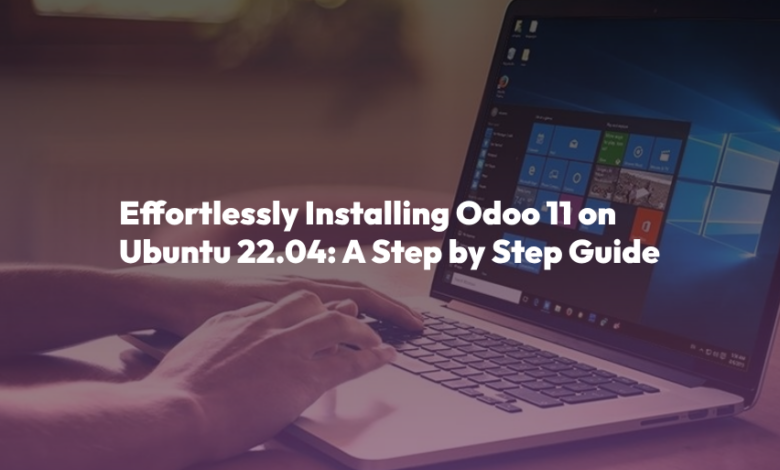Effortlessly Installing Odoo 11 on Ubuntu 22.04: A Step by Step Guid

Introduction
Odoo is a versatile, open-source business management software suite that includes a wide range of applications and modules for various business needs. It’s a powerful tool that can help businesses streamline their operations, manage finances, and improve productivity. In this step-by-step guide, we will walk you through the process of installing Odoo 11 on Ubuntu 22.04. Whether you’re a business owner looking to implement Odoo or an IT professional tasked with the installation, this guide will make the process easy and straightforward.
Prerequisites
Before we dive into the installation process, let’s make sure you have all the necessary prerequisites in place.
1.Ubuntu 22.04 LTS: Make sure you have a fresh installation of Ubuntu 22.04. You can download the ISO file from the official Ubuntu website and create a bootable USB drive.
2.SSH Access: Ensure that you have SSH access to your Ubuntu server. If not, you can enable it by running the following command:
sudo apt install openssh-server
3.Update Your System: It’s always a good practice to update your system before installing new software. Run the following commands to update your Ubuntu system:
sudo apt update
sudo apt upgrade4. Python and Pip: Odoo is written in Python, so make sure you have Python 3 installed. You’ll also need pip, Python’s package manager. Install them with the following commands:
sudo apt install python3 python3-pipInstalling Odoo 11 on Ubuntu 22.04
Now that you have your prerequisites in place, let’s proceed with the installation of Odoo 11.
Step 1: Create a System User
It’s a good practice to create a dedicated system user for running Odoo. This enhances security and isolation. Run the following command to create a new user:
sudo adduser --system --home=/opt/odoo --group odooStep 2: Install and Configure PostgreSQL
Odoo requires a database to store its data, and PostgreSQL is a popular choice. Install PostgreSQL and create a new user for Odoo:
sudo apt install postgresql
sudo su - postgres
createuser --createdb --username postgres --no-createrole --no-superuser --pwprompt odoo
exitStep 3: Install Dependencies
Odoo has several dependencies that need to be installed. Run the following command to install them:
sudo apt install python3-dev libxml2-dev libxslt1-dev zlib1g-dev libsasl2-dev libldap2-dev build-essential libssl-dev libffi-dev libmysqlclient-dev libjpeg-dev libjpeg8-dev liblcms2-dev libblas-dev libatlas-base-dev libopenjp2-7 libtiff5 libjpeg62 libjpeg62-dev libfreetype6 libfreetype6-dev zlib1g libwebp6 libwebp-dev libwebpdemux2 libwebpmux3 libx11-dev libpq-dev libjpeg8-dev liblcms2-dev libblas-dev libatlas-base-dev libbz2-dev libreadline-dev libjpeg-dev libssl-dev libjpeg8 libjpeg62 libjpeg62-dev libxslt1-dev libsasl2-dev libldap2-dev libffi-dev libmysqlclient-devStep 4: Install Wkhtmltopdf
Wkhtmltopdf is a tool that Odoo uses for generating PDF reports. Install it by running the following commands:
sudo apt install -y wkhtmltopdf
Step 5: Install and Configure Odoo
Now it’s time to install Odoo itself. You can use pip to install Odoo 11:
sudo pip3 install odoo==11.*Once Odoo is installed, create a configuration file for it:
“`
sudo nano /etc/odoo.confIn the configuration file, add the following content, adjusting the parameters as needed:
[options]
; This is the admin password for the Odoo web interface.
admin_passwd = YOUR_ADMIN_PASSWORD
db_host = False
db_port = False
db_user = odoo
db_password = False
logfile = /var/log/odoo/odoo.log
addons_path = /opt/odoo/addonsSave and close the file. Replace `YOUR_ADMIN_PASSWORD` with a secure password for the Odoo admin account.
Step 6: Set Permissions and Create Log Directory
Set the correct permissions for the Odoo system user and create a log directory:
sudo chown odoo: /etc/odoo.conf
sudo mkdir /var/log/odoo
sudo chown odoo:root /var/log/odooStep 7: Create a Systemd Service
Create a systemd service file to manage Odoo as a service:
sudo nano /etc/systemd/system/odoo.serviceAdd the following content to the service file:
[Unit]
Description=Odoo
Documentation=http://www.odoo.com
[Service]
# Ubuntu/Debian convention:
Type=simple
User=odoo
ExecStart=/opt/odoo/venv/bin/python3 /opt/odoo/venv/bin/odoo -c /etc/odoo.conf
[Install]
WantedBy=default.targetSave and close the file.
Step 8: Enable and Start Odoo Service
Enable the Odoo service and start it
sudo systemctl enable odoo
sudo systemctl start odooStep 9: Configure Your Firewall
If you have a firewall enabled, make sure to allow incoming traffic to the Odoo port (default is 8069) by running the following command:
sudo ufw allow 8069/tcpStep 10: Access Odoo Web Interface
You can now access the Odoo web interface by opening a web browser and navigating to your server’s IP address or domain name followed by `:8069`. For example, `http://your_server_ip:8069`.
Conclusion
Congratulations! You have successfully installed Odoo 11 on Ubuntu 22.04. You can now start configuring Odoo to suit your business needs, including setting up modules, users, and customizing your instance. Odoo is a powerful tool that can help streamline your business operations, so take advantage of its features and capabilities to drive productivity and efficiency in your organization. If you encounter any issues during the installation process or while using Odoo, refer to the Odoo documentation or community forums for assistance. Enjoy the benefits of Odoo and boost your business management capabilities.
In this blog post, we’ve provided a comprehensive, step-by-step guide to installing Odoo 11 on Ubuntu 22.04. By following these instructions, you can easily set up Odoo and leverage its powerful features for your business. Whether you’re a small business owner or an IT professional, this guide will help you get started with Odoo on Ubuntu 22.04.



